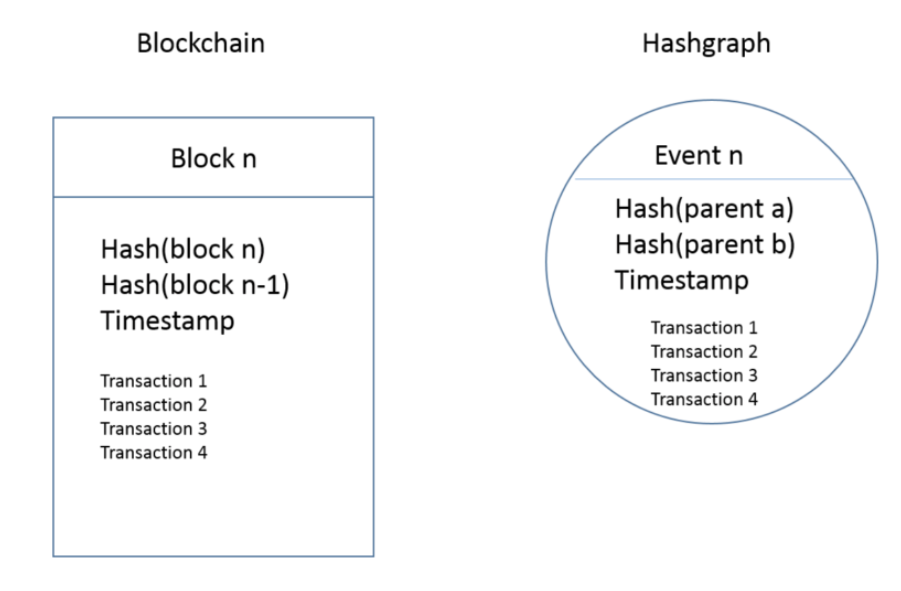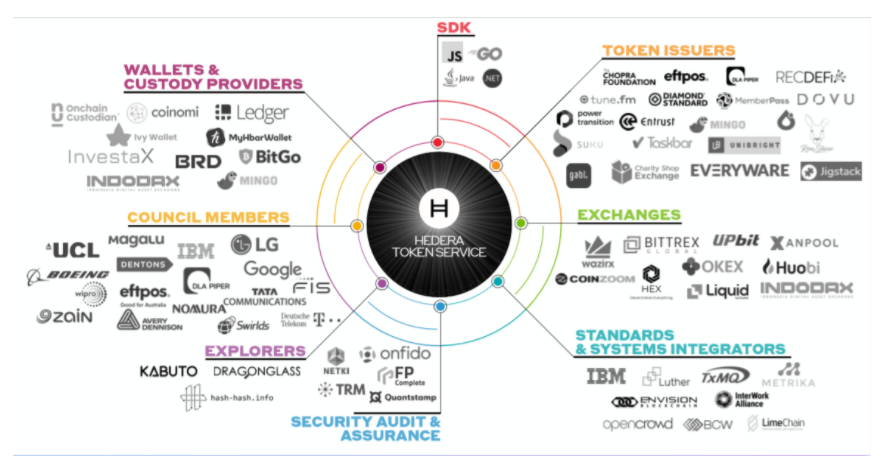
The promise of a faster, safer, and more efficient blockchain has been promoted ever since Ethereum became the leading blockchain due to its easy-to-integrate solution. Since then, each new blockchain project has strived to build a faster, more cost-efficient blockchain to meet the growing demand for distributed ledger technology (DLT) integration. New pillars for blockchain technology have been developed, starting from 2017 with blockchains such as NEO, TRON, and Waves, aiming to improve accessibility by creating new ecosystems.
The growing demand for the private sector to create interoperable and secure ledgers without the immediate need for decentralization has generated new opportunities. Hedera Hashgraph is one of the projects that offers a closed-source solution for corporate entities, using its patented Hashgraph. First released in 2016 and described initially as the “blockchain killer“, it gradually evolved toward a public ecosystem in 2019 with the release of its mainnet.
What is Hedera Hashgraph?
Hedera Hashgraph is the third generation of distributed ledgers, operating differently from existing blockchains. Its core value is the Hashgraph, which works similar to a blockchain, although data is stored in hashes and not in blocks. Transactions in the network are verified through the gossip protocol, allowing information to be verified faster as more transactions enter the network.
Sponsored
Hedera Hashgraph consists of two parts. Firstly, the project’s main value proposition is the patented Hashgraph and its consensus mechanism, which generates faster transactions. Secondly, users of the Hedera ecosystem (which are mainly enterprises) can, through smart contracts, deploy DAPPS that make use of the native HBAR token. The ecosystem can have multiple applications that are already available on other networks such as DeFI, identity management, or gaming.

In essence, Hedera Hashgraph is a network aimed at the enterprise sector, which promises faster and more secure transactions using the Hashgraph consensus.
Where It All Started For The “Blockchain Killer”
The first iteration of the Hashgraph was created in 2016 when Swirlds CEO, Dr. Leemon Baird, developed the innovative DLT. Similar in many ways to Ethereum, it was aimed at the corporate sector first, offering transaction transparency and security through the DAG. Hedera Hashgraph was launched as Swirlds Hashgraph and was first used in the financial sector after a consortium of 6,000 banks decided to create an interoperable network for all consortium entities.
Sponsored
In 2018, Hedera launched an ICO to raise $120 million to increase the project’s functionality by adding smart contracts and file storage similar to Filecoin and offering cryptocurrency to support micropayments on their network. They raised a total of $100 million and were also backed in the early stages by large enterprises such as Boeing, IBM, and T-Mobile as the project was targeting their specific business needs.
Hedera is governed by 39 organizations and enterprises, a combination of private and legal entities (including such multinationals as IBM and Boeing) that help oversee the software. Given the potential implications and legal precedents at stake, it is unlikely that any governors will alter the nodes. Nodes on the network will deploy globally to help verify transactions through their native protocol.
On the Flipside
- Patenting the Hashgraph could limit the integration of the DLT into the growing Web 3.0.
- Putting the centralized node structure into the hands of multinational companies defeats the purpose of decentralization.
- Developers are also prevented from forking the protocol and creating better public use cases.
- The network is currently capped to 10 transactions per second (tps) for transactions that invoke a smart contract. This is similar to Ethereum’s tps rate.
- There are over 1,000 blockchain projects that are forkable and can easily be used publicly.
Hashgraph Explained
At its core, Hashgraph differentiates from blockchain through the way it reaches consensus and stores data. The Hashgraph, in its essence, is a store of data and consensus algorithm that doesn’t use blocks or miners/staking to reach a consensus. Data is stored in individual hashes on the network, and consensus is reached through the gossip protocol and virtual voting.
With close circuit governance, where only approved entities are allowed to participate and run a node, Hedera avoids polluting transactional information with unknown nodes. Hedera’s limiting factor gives enterprises confidence in the stability and credibility of the Hashgraph.

The Hashgraph architecture creates events in two different hashes, a timestamp of when the event occurred and the number of transactions recorded in that event. Transaction information stored in the event is not unknown to the other participants in the adjacent nodes.
The gossip protocol is then used to enable communication between nodes. When an event is created, the participants send data to two nodes, which then each send that data to two other nodes. This creates a high flux of information through the network, and data grows exponentially, leading to a gossip sync, as explained by Hedera. While passing data is not sufficient to reach consensus, each node in the network shares data with all the nodes about each transaction’s chronology in the form of a timestamp.
The consensus running on the Hashgraph, “Gossip about Gossip”, means that each node on the network will share all the data it currently has from the gossip sync. In other words, each node shares the exact order of all transactions performed on the Hashgraph. They communicate with each other and compare the type of data they have received from each node to validate if the information is accurate and the absolute truth.
What occurs on the network is a form of “virtual voting” where none of the nodes validate an event. Still, by knowing everything that occurs in the network through gossip, each node can have an idea of how each node behaves and can validate the consensus without actively voting. This decreases transactional time as voting does not occur on the network, and no other computations are required.
By decreasing transactional times through the “Gossip about Gossip” protocol, the number of transactions on the network can increase. With less information traveling through the network, the Hashgraph can process more transactions (up to 10,000 transactions per second).
The Hashgraph Is Mathematically Proven
Interestingly enough, the consensus concept integrated into the Hashgraph has been used in a slightly different form to provide security for the past 35 years. Given the complexity associated with the validation process, mathematically speaking, it’s nearly impossible to trick the network, giving enterprises a much-needed safety buffer.
As the Hashgraph initiators emphasized in their whitepaper, their DLT is the only asynchronous Byzantine fault tolerance (aBFT) ledger and has been publically reviewed since 2016. It has also been mathematically proof checked “using the Coq System in 2018.”
Where Is Hedera Hashgraph Heading?
At the time of writing, HBAR is priced at $0.34 and has been holding above the resistance level after going parabolic on March 13. This is not surprising, as the company has been active in growing systematically across the globe as previously described. They’ve recently partnered with Africa’s largest bank by assets, Standard Bank Group, helping them facilitate cross-border payments more efficiently. Entry into the African market is one of their many milestones Hedera has stomped through in the past year.
Clearly, Hedera Hashgraph can be a credible solution for companies and projects that require elevated ledgers that provide high levels of security for their data. That is one of the reasons Everyware is working with Hedera to provide a private database for UK hospitals to manage vaccine storage and administration. Hedera has helped Everyware to offer an additional level of trust through their patented DLT.
Without a doubt, Google and IBM have strong foundational grounds to develop Hedera Hashgraph into an easy-to-use and integrated ledger solution in the future.

The company’s roadmap shows that it aims to provide a solution for every demand and become the go-to ledger for enterprises adhering to upcoming trends. Their 2021 goals indicate Hedera plans to showcase the accessibility and functionality of their platform with layer 2 demos for NFT. They continue to improve their ecosystem by adding new uses such as automated congestion pricing and interoperability with third-party protocols.
Although Hedera Hashgraph is aimed toward centralized entities and is being governed by large multinationals, it has displeased decentralization devotees because they believe it disregards the ethics of decentralization. However, with their value proposition firmly rooted in meeting the corporate world’s needs, the Hashgraph can serve as a probable solution to scalability issues found in the current blockchain ecosystem.
Across the globe, Hedera has offered solutions and showcased the fact that their DLT can be beneficial. If the Hashgraph proves successful in the Web 3.0 era, it could serve as the backbone of an ecosystem with unlimited potential for scalability. The Hashgraph can facilitate connections between all the internet worlds that are currently being built. By enabling the DLT proposed by the Hashgraph, people building such bridges can focus on efficiency without having to worry about security as it is enabled by default.
